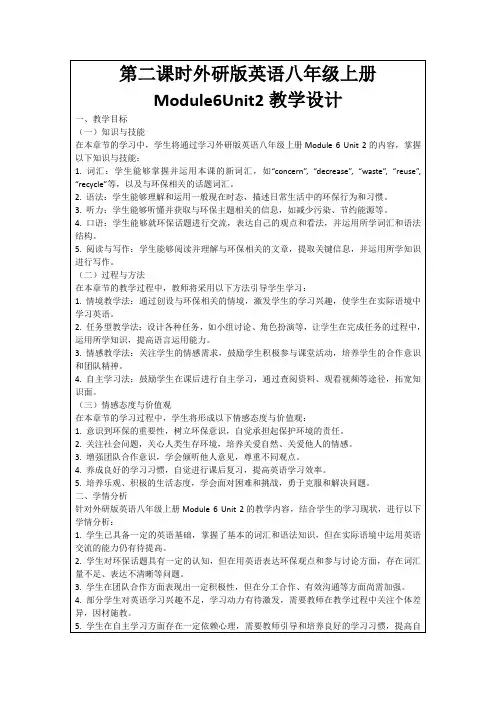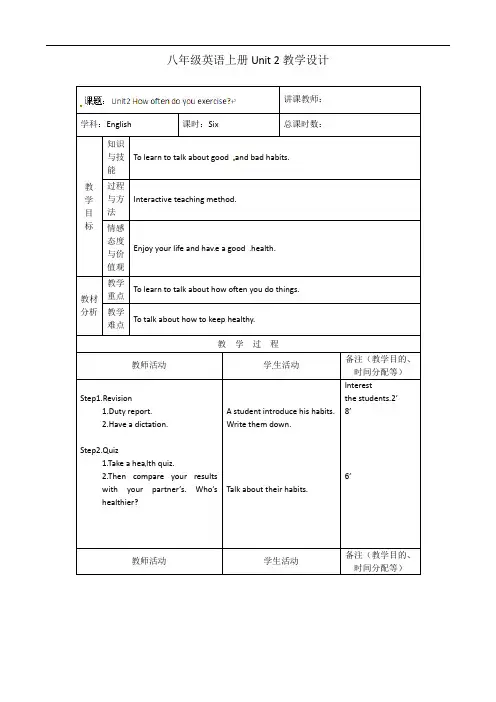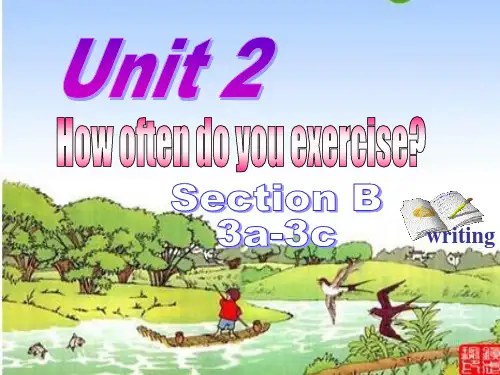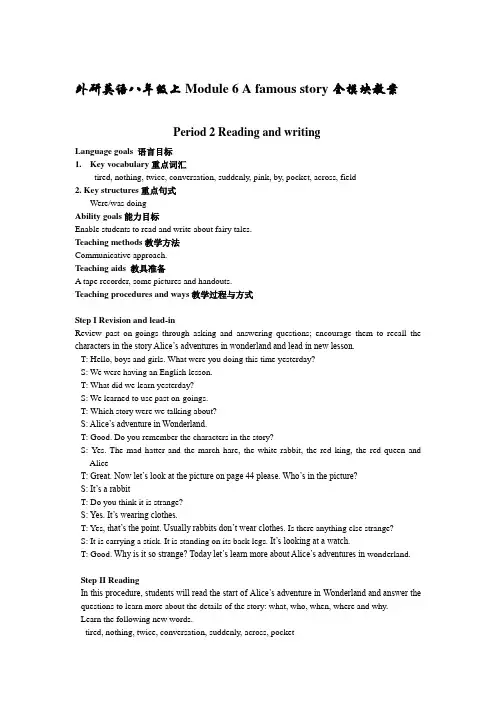2013八年级英语上unit2第六课时教案
【备课】英语北师大版八年级上册Unit2Lesson6ASpecialTeam教案

Unit 2 Lesson 6 A Special Team教学目标.通过阅读短文,获取有关一个团队在地震中如何自救的信息、;1.通过阅读,在语境中了解resort, flashlight等词的语义;初步运用call for one' s attentionencourage, support 等有关地震和团队的词汇;教学重难点体会在地震这种特殊的时期团队的重要性。
教学过程一、导入study teamfootball teamrescue (救援)teamTeamWhy do we need teams?Because team members can encourage and support each other,and solve the problem together.A Special TeamWhy is the team special? What happened to them?二、新课学习on holiday在度假When I was on holiday, I visited my uncle.我在度假的时候去看望了叔叔O I do not like to travel during the holiday season.我不喜欢在度假的季节去旅游。
one by onePlease retell the story one by one.一个接一个地复述故事。
We went into the room one by one.我们挨个儿走进房间。
at that momentAt that moment my heart is full of joy andthankfulness.此时,我的心充满了欢乐与感激。
Just at that moment, the door opened and the teacher walked in.就在那时,门翻开了,老师走进来。
第二课时外研版英语八年级上册Module6Unit2教学设计

(二)讲授新知,500字
在导入新课之后,我将系统地讲授以下新知识:
1.词汇教学:通过PPT展示新词汇,如“concern”, “decrease”, “waste”, “reuse”, “recycle”等,并配以例句和图片,帮助学生理解和记忆。
四、教学内容与过程
(一)导入新课,500字
在本节课开始时,我将通过以下方式导入新课:
1.展示图片:呈现一系列与环保相关的图片,如污染的河流、垃圾分类等,引导学生观察并思考这些图片所传达的信息。
2.视频引入:播放一段关于环保的宣传视频,让学生了解环保的重要性,激发他们的学习兴趣。
3.问题引导:提出问题,如“Do you think it's important to protect the environment?”和“What can we do to save energy and reduce waste?”让学生思考并展开简短讨论。
4.自主学习法:鼓励学生在课后进行自主学习,通过查阅资料、观看视频等途径,拓宽知识面。
(三)情感态度与价值观
在本章节的学习过程中,学生将形成以下情感态度与价值观:
1.意识到环保的重要性,树立环保意识,自觉承担起保护环境的责任。
2.关注社会问题,关心人类生存环境,培养关爱自然、关爱他人的情感。
3.增强团队合作意识,学会倾听他人意见,尊重不同观点。
1.词汇巩固:请学生将本节课学习的新词汇整理成词汇表,并尝试用这些词汇造句,加深对词汇意义的理解。
-提示:可以结合日常生活中的环保行为,如“Reducing paper usage at school is an effective way to save trees.”
八年级英语上册_Unit2教案 (6)

八年级英语上册Unit 2教学设计讲课教师:学科:English 课时:Six 总课时数:教学目标知识与技能To learn to talk about good and bad habits.过程与方法Interactive teaching method.情感态度与价值观Enjoy your life and hav e a good health.教材分析教学重点To learn to talk about how often you do things.教学难点To talk about how to keep healthy.教学过程教师活动学生活动备注(教学目的、时间分配等)Step1.Revision1.Duty report.2.Have a dictation.Step2.Quiz1.Take a hea lth quiz.2.Then compare your resultswith your partner’s. Who’shealthier? A student introduce his habits.Write them down.Talk about their habits.Interestthe students.2’8’6’教师活动学生活动备注(教学目的、时间分配等)Step3.Self Checkple te the chart withactivities you do and don’t do.2.Talk about your father or yourmother’s activities.3.Write five sentences using theinformation above.4.Fill in the blanks in theconversation.Step4.PracticePractice the conversation inpairs.Step4.ExercisesDo some exercises.Step5.SummurySum up the main knowledge inthi s class.Step6.HomeworkWrite a passage about yourfriend’s ha bits.Talk about theirparents’ eating habits.Finish them.Try to say out the main knowledge.6’5’5’5’8’2’板书Unit2 How often do you exercise?1.a few times a week2.almost every day3.less than4.go to the shopping c enter5.be like。
2013秋人教版英语八年级上Unit2课件 第6课时课件

twice a week.
写作指导
• 1.写作目标 本次写作内容是写出自己好的生活习惯和 不好的习惯的频率。 • 2.审题指导 (1).人称:以第一人称为主。 (2).时态:以一般现在为主。
3.思路点拨
开头:介绍自 己,引出主题
I am...,Let me tell you something about myself
主体:介绍好的习 惯和不好的习惯
I have a lot of good habits:... However,I have some bad habits:....
结尾: 你的看法
I think we should have good habits.They are good for us
3c Write a report about your good and bad habits. Say
exercise
every day
eat a lot of vegetables always
eat fruit
every day
drink milk
every day
sleep eight hours
never
every night
Bad habits eat junk food
drink coffee
how often you do things. Use the report in 3a as an example.
_____________________________________ _____________________________________ _____________________________________ _____________________________________ _____________________________________ _____________________________________ _____________________________________ _____________________________________ _____________________________________ _________________________________
外研版英语八年级上Module6Unit2教案

外研英语八年级上Module 6 A famous story全模块教案Period 2 Reading and writingLanguage goals 语言目标1.Key vocabulary重点词汇tired, nothing, twice, conversation, suddenly, pink, by, pocket, across, field2. Key structures重点句式Were/was doingAbility goals能力目标Enable students to read and write about fairy tales.Teaching methods教学方法Communicative approach.Teaching aids 教具准备A tape recorder, some pictures and handouts.Teaching procedures and ways教学过程与方式Step I Revision and lead-inReview past on-goings through asking and answering questions; encourage them to recall the characters in the story Alice’s adventures in wonderland and lead in new lesson.T: Hello, boys and girls. What were you doing this time yesterday?S: We were having an English lesson.T: What did we learn yesterday?S: We learned to use past on-goings.T: Which story were we talking about?S: Alice’s adventure in Wonderland.T: Good. Do you remember the characters in the story?S: Yes. The mad hatter and the march hare, the white rabbit, the red king, the red queen and AliceT: Great. Now let’s look at the picture on page 44 please. Who’s in the picture?S: It’s a rabbitT: Do you think it is strange?S: Yes. It’s wearing clothes.T: Yes, t hat’s the point. Usually rabbits don’t wear clothes. Is there anything else strange?S: It is carrying a stick. It is standing on its back legs. It’s looking at a watch.T: Good. Why is it so strange? Today let’s learn more about Alice’s adventures in wonderland.Step II ReadingIn this procedure, students will read the start of Alice’s adventure in Wonderland and answer the questions to learn more about the details of the story: what, who, when, where and why.Learn the following new words.tired, nothing, twice, conversation, suddenly, across, pocketAnd then ask students to read individually and discuss the questions with a partner.Check the answers. Ask them to read again and decide whether the following sentences are true or false.1.Alice was reading a book.2.The book had a lot of pictures in it.3.Alice wanted to make daisy chain.4. A white rabbit ran past Alice and her sister.5.The rabbit was wearing clothes.6.The rabbit went into a hole under a big tree.7.Alice entered the hole after the rabbit.Check the answers.Step III WritingIn this step, students will do the match work first to know something about Lewis Carroll. Introduce more about Lewis Carroll to them and then ask them to write the story of Lewis Carroll and Alice LiddellT: Last period, I asked you to find some information about the writer of the story, have you finished?S: Yes.T: Can you tell me who the writer is?S: Lewis Carroll.T: Good. Today let’s learn more about the writer. Let’s learn why and how he wrote this story? Ask students to read the questions and answers fast, make sure they understand each one, and then let them do the match work.After a few minutes, call back the answers from the whole class, having one student ask a question and another answer. Explain when necessary.If possible, introduce more about the writer. (See Teaching resources: I)Then ask students to make a list of the information of Lewis Carroll and Alice Liddell and then join the sentences with “one day…, then…, and finally…”to write the story.When they have finished, ask some of them to read their story to the class.Sample version:Lewis Carroll’s real name was Charles Dodgson. He was tea ching math at the University of Oxford, England. One day he saw Alice in a garden. She was playing with her sisters. Carroll went to meet the girls and they asked him to take their photos. He became good friends with the Liddell children. One day they were having a picnic by the river, and Carroll was telling the girls lots of stories. Alice asked him to wri te down the stories. Then Carroll wrote Alice’s Adventures in Wonderland. Finally Alice’s Adventures with Lewis Carroll ended when she grew up.When they have finished, ask some of them to read their story to the class.Step IV HomeworkAsk students to1.make sentences with the phrases: Once or twice, look into, what…for…, b e doing…when…,think of, grow up, have a picnic.2.do activities 5-6 in the workbook.。
北师大版八年级英语上册教案Unit 2 lesson 6 北师大

Unit 2 TeamsLesson 6 A special teamThis lesson is the sixth lesson of unit 2 in the eighth grade of junior high school English. The topic is the team. The third class of this class for this unit, mainly discuss about how people in earthquake under this special time, relying on the power of the team out of the dilemma, for the final basis for language comprehensive language output of this unit. The lesson focuses on the understanding of reading content, and guides the students to obtain information about how to save themselves in the earthquake by reading. In the reading activity, guide the students to extract the main information and details, and pay attention to the related vocabulary used in the description of an earthquake, and finally combine the text information and language to carry out the output activities.【知识目标】special, couple, resort, earthquake, dark, heavily, ruins, blanket, flashlight, flash, etc.shake, completely, call for one’s attention, enough, divide, encourage, support, etc.【能力目标】Read the passage and get information about how a team saved themselves in the earthquake.【情感目标】Understand the semantics of resort, flashlight and other words in the context through reading. Feel the importance of the team during the earthquake.【教学重点】Review the vocabulary by selecting the words to fill in the blanks and completing the evaluation form;【教学难点】How to train their ability step by step.Multimedia.Step 1. Warm upearthquake 地震a very strong earthquakeruin 废墟Who are they?What are the people doing?a teama special team一个特殊的团队resort 旅游圣地mountain resortan old couple一对夫妇The old couple was on holiday at a mountain resort.They were taking a walk.It was dark. 黑暗的It started to rain heavily. 下大雨Step 2.1st readingWhich is the main idea?A. How a group of people saved others after an earthquake.B. How a group of people helped each other after an earthquake. Step 3.Fast readingComplete the sentences with correct numbers.1. The earthquake lasted for ____ minutes.2. The Lins found ____ people at the resort.3. Mr. Lin divided the 25 people into ____ groups.4. It took the team ____ hours to get out safely.Step 4. ReadingWhat is the structure of the story?Setting _____________Development ______________Ending ____________Step 5.Reading---Part I (para. 1-2)In the early afternoon.At a mountain resort.Mr Lin, Mrs Lin and 23 other people.Step 6. ReadingThey were taking a walk when suddenly the ground started to __________.In just two minutes, everything changed_______________.The Lins found 23 other people. Soon it was _______, and it started to __________________. Some cried and some ______________.Step 7. Reading---Part II (para. 3-5)How many blankets did they find?How did they solve the problem?What did the group leaders do?Why did they do that?Was it easy?How did they make it?Step 8. Reading---Part III (para.6) What was the ending like?They got out safely.Step 9. DiscussionA Special TeamWhy did they feel lucky?小组讨论。
Unit2Whosthat第六课时教案
Unit 2 Whos that?第六课时Lesson12教案示例重点:复习巩固本单元重点内容难点:语音过程:一、热身/复习1.组织学生唱英文歌曲HappyTeacher’sDay和韵文Who’she?Who’sshe?教学开始时,为了帮助学生很快的进入学习状态,唱首英文歌曲,起到活跃课堂气氛以及复习知识的作用。
2.师生之间、学生之间进行问答练习(结合本单元所学的重点句子。
)二、会话练习与教学方法1.听本课的会话整体录音一遍(配套教材录音)2.然后让学生模仿录音进行跟读3.最后让同桌的两个学生结合成小组进行练习4.教师针对课文进行提问,请个别学生回答。
从回答中教师可以了解到学生是否理解了课文内容Howmanypeople?Who’stheboyoverthere?IsheAmerican?Who’sthegirl?5.学生之间问答找学生到教室前面对其他学生提问题,问题范围:Who’she/she?Who’stheboy/girl/woman/man?Who’sthat/this?Ishe/sheathome?学生之间进行问答,可以提问本组成员,也可以提问自己的好朋友,更鼓励学生按学号找学生回答。
(提问时可以用自己带来的照片,也可以借用别人的照片)5.对话表演请学生从学过的五篇对话中找出自认为掌握的最好的一篇,找自己座位周围的同学结合成小组,准备对话表演。
对话表演(三至四组)三、语音及拼读练习1.教师板书字母Oo,并标上读音[EU],然后对全班说:Readitple 依照此法复习其他音标2.游戏:音标和单词配对准备:自制36张游戏纸牌(也可用旧纸牌进行修改),其中的一半,每张写一个英语单词;纸牌的另一半,每张写一个与这些单词相适应的国际音标。
例如:一张blue,一张[blu:]。
操作:开始时,把纸牌洗匀,全部背向上一张一张扣在桌面上。
每人轮流翻看两张纸牌,凡是翻到单词和国际音标配对的,就把两张取出,放在自己身边,并且还有翻看纸牌的权利。
八年级英语上册 Unit 2 How often do you exercise(第6课时)Section B(2b-2e)课件
二、用所给词的适当形式填空。
6.Mo Yan is a very great________(write) . writer
7.The best way__________________(exercise)is to run every day. to exercise 8.Liu Li learns English by________(use)the Internet. using
第六课时
Section B(2b~2e)
1.such as 意为“例如;像”。用来对上文所说的事情列出事例,其前可用“ ,”号与前面句子隔开,其后不能加“,”。 2.It's good to relax by using the Internet or…通过用因特网或者 ……放松是好的。 by prep.意为“通过(方式,手段)”,by后需跟名词、代词或动名词 。 3.…the best way to relax is through exercise.最好的放松方式是运 动。 (1)to relax 是动词不定式作定语。 (2)through prep.(指方法,手段等)经由;以;用;凭借。
A.healthy B.health
C.be health D.to be healthy
B 12.—________do you sleep every day?
—Eight hours. A.How often B.How long
C.How much D.When
13.Here________my family photos. D A.is B.be C.a D.are
D.Three times a week. B 22.The underlined word “increased” means “________” in Chinese. A.减缓 B.增加 C.加快 D.减弱
八年级上 unit2 第六课时 导学案
八年级英语学科导学案编写人:初审人:审核人:使用时间:第六课时Unit 2 How often do you exercise ? Section B3a-self check班级:______ 姓名:__________ 【使用说明及学法指导】1. 学生个人课前以预习案内容为主 朗读并记忆四会单词的意义及用法。
2. 找出本节课要学到的有关短语 两人英汉互译合作记忆。
3. 探究案以两人或小组合作学习为主解决 有争议或无法确定的内容教师辅助解决。
4. 训练案当堂完成 学生分层次进行对改展示 教师适当进行点拨和指导。
5. 我的收获由学生和教师分别完成 对本节课做简要总结 以利改进和提高。
【学习目标】一.知识目标:学习并掌握词汇:visit the zoos, take some photos, go to the countryside 学习目标语言:How was the trip? It was …二.能力目标:学会写日记。
三.情感目标:通过对旅行的回忆来更加热爱生活。
重难点:学会写日记。
【预习案】一.已学知识回顾()1. We got ______ when we heard the ______ news.A. excited; excitingB. excited; excitedC. exciting; excited()2. Jim is a very _____ person and we are ______ in his story.A. interested; interestingB. interesting; interestedC. interested; interested()3. He ______ one of ______friends at the station yesterday afternoon.A. saw; himB. saw; hisC. sees; his()4.—How was your school trip?—Pretty good! We ______the history museum.A. visitB. visitedC. will visit()5.Pardon? I ______ hear you. A. don’t B. didn’t C. can’t 二.预习指导1. 根据图片和文章等,预测新课内容;2. 自学课文,完成Self Check中的练习。
294.初中英语八年级上册-Unit 2 How often do you exercise(第6课时)教案(人教新目标版).doc
Unit 2 How often do you exercise(第6课时)讲课教师:学科:English 课时:Six 总课时数:教学目标知识与技能To learn to talk about good and bad habits.过程与方法Interactive teaching method.情感态度与价值观Enjoy your life and hav e a good health.教材分析教学重点To learn to talk about how often you do things.教学难点To talk about how to keep healthy.教学过程教师活动学生活动备注(教学目的、时间分配等)Step1.Revision1.Duty report.2.Have a dictation.Step2.Quiz1.Take a hea lth quiz.2.Then compare your results with yourpartner’s. Who’s healthier? A student introduce hishabits.Write them down.Talk about their habits.Interestthe students.2’8’6’教师活动学生活动备注(教学目的、时间分配等)Step3.Self Checkple te the chart with activitiesyou do and don’t do.2.Talk about your father or yourmother’s activities.3.Write five sentences using theinformation above.4.Fill in the blanks in theconversation.Step4.PracticePractice the conversation in pairs.Step4.ExercisesDo some exercises.Step5.SummurySum up the main knowledge in thi s class.Step6.HomeworkWrite a passage about your friend’s ha bits. Talk about theirparents’ eating habits.Finish them.Try to say out the main knowledge.6’5’5’5’8’2’板书Unit2 How often do you exercise?1.a few times a week2.almost every day3.less than4.go to the shopping c enter5.be like。
- 1、下载文档前请自行甄别文档内容的完整性,平台不提供额外的编辑、内容补充、找答案等附加服务。
- 2、"仅部分预览"的文档,不可在线预览部分如存在完整性等问题,可反馈申请退款(可完整预览的文档不适用该条件!)。
- 3、如文档侵犯您的权益,请联系客服反馈,我们会尽快为您处理(人工客服工作时间:9:00-18:30)。
八上Unit1第六课时Section B 3a - Self Check (写作课)Step1 Pre-writing activities:1.Teaching goals:1) 词汇和常用表达:duck, dislike, buy something special, learn somethingimportant, dislike doing sth.2) 语法:学会运用不定代词和一般过去时态。
I bought something special. I learned something important.The weather was hot and sunny.We took some photos.In the evening, I felt really tired.3) 话题和功能:学会用一般过去时写作有关假日旅游的日记。
4) 文化知识:了解国内外部分著名旅游景点。
5) 学习策略:利用信息归类和时间链等方法拟定写作提纲,提高写作技巧和能力。
2. Revision(话题复习):1) 写出下列动词的过去式:take buy see watch starteat climb go bring findread keep get learn arrive2) 短语翻译:美味的食物漂亮的鲜花天安门广场故宫博物院开始我们的旅行如此...以致于...继续前进到达(山)顶部又蹦又跳到乡村去【设计意图】坚持“以生为本,先学后教”的理念,强调学生的参与、体验、感知,落实基本语言点,以学定教,教师根据具体学情适当微调后续环节的教法。
学习一般过去时态就要从动词的过去式入手,为后续的环节积累储备词汇。
3.Leading- in(导入):T: We have learned some interesting places in the world such as Central Park , Hong Kong, Huangguoshu Waterfall , Penang in Malaysia and so on.Today,we'll learn to writ e a diary entry about our trip to some place. Imagine you took a trip to Beijing during last summer vacation.4.Talk about some pictures(看图说话):There are lots of tourist attractions and something interesting in Beijing. Let's have a look.Make one or two sentences about each picture using the simple past tense. For example,This summer I went to the Great Wall in Beijing. It was beautiful.【设计意图】利用精美的图片激发学生练习说话的热情,这种深入浅出的“开场白”,具有承前启后,温故而知新的作用,且有利于中下等学生进入状态,扎实推进。
5. Complete the passage(短文填空):Activity 3a. Read the expressions in the box and make sure you know the meaning of each one.Complete the diary entry in 3a using the words or expressions above . After 2 minutes, check theanswers.【设计意图】复习相关词汇,引导学生进行写作前的热身活动,并为下一步结构分析作准Hot and sunny tired Beijing duck deliciousTake some photos beautiful Buy something special interestingLearn something important August备。
6. Structure analysis(信息归类结构分析):1) Put the above expressions to the right place in the chart:TimeWeatherActivitiesFoodDescription wordsCheck the answers. Have the students to read the diary aloud by themselves.2) Look at the following disordered sentences, put them into the right order.We took some photos.For dinner, we ate Beijing duck.Today the weather was hot and sunny.In the evening we felt tired.I went to Tian'anmen square.It was really big and beautiful.I liked this place because I learned something important.It was delicious.Get the students to collate the sentences individually or in pairs. Then check the answers:C → E → F → A→ G → B → H → D3) Now think about this question: How can we put them into the correct order?You can answer in English or in Chinese.S1:....S2:....S3:....T: So ,in order to put them into the correct order, we must pay attention to the timeline (时间链)such as Today the weather..., For dinner..., In the evening...,...【设计意图】本环节设计了两项活动:信息归类和句子重排,旨在引导学生积累写作材料,了解日记的主体结构,学习文章布局技巧,知晓日记文体在时态、活动、描述词汇等方面的要求。
7. Talk about reality(谈论实际)T: Class, National Day is coming. Where did you go on a trip during last National Day vacation? Write your own travel diary. You can imitate the diary in 3a.You can also add some more information if possible.【设计意图】由布局谋篇的技巧学习过渡到实际运用,从热身活动过渡到实际“下水”。
Step2 While-writing activities:1. Write an outline(拟定提纲)First , answer the questions in 3b to make notes about a vacation. Discuss them in pairs and write some key words in the following chart:TimeWeatherActivitiesFoodDescription wordsT: Prepare your diary orally according to the details in the chart and I'll ask someone to read to the class.Give Ss 3 or 4 minutes to write an outline. Sample:Tuesday, August 20thI had a ..... It was .... In the morning, .... I ..., and.... We...,.... I went to .... For dinner,.... After lunch,.... We saw.... There were .... They were .... In the afternoon, .... I bought.... It's time to go back...,.... I felt.... I think today is...【设计意图】正如语文课上写作文要先打草稿一样,拟草稿是写好英语作文的第一步。
在此框架内填枝加叶,充实内容,才能一步步顺利成篇。
2. Write the draft(起草初稿)Write the draft in your exercise book.3. Revise the draft(修改初稿)Here is an evaluation scale(评价标准). Have a look.Is there a topic sentence(主题句)?Is there a timeline?Did I use the past tense verbs?Are there any grammatical mistakes(语法错误)?T: Modify each other's diary in pairs according to the evaluation scale above. Correct mistakes as possible as you can.【设计意图】以学习小组为单位,互评互改,在批改中学习,在批改中提高,取长补短,即所谓“兵教兵”。
与教师逐篇批改相比,这种做法省时省力见效快。
Step3 Post-writing activities:1. 展示评价1) Each group hands in one diary . Teacher shows them on the screen and evaluate them one by one.2) Choose several Ss to evaluate the diary item by item in the evaluation scale.3) Each group elect the best piece from all the diaries of them and give them to the teacher.T: I'll show them on the screen. The group leaders will give a grade (等级) to each diary according to the evaluation scale.A. bestB. betterC. goodD. just so-soPraise top three diaries .4)Get all the students to transcribe their diaries on page 7 in the textbooks.【设计意图】教师从不同小组随机抽取3-5篇日记,投影到大屏幕。
